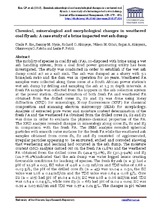| dc.description.abstract | The mobility of species in coal fly ash (FA), co-disposed with brine using a wet ash handling system, from a coal fired power generating utility has been investigated. The study was conducted in order to establish if the wet ash dump could act as a salt sink. The ash was dumped as a slurry with 5:1 brine/ash ratio and the dam was in operation for 20 years. Weathered FA samples were collected along three cores at a South African power station’s wet ash dump by drilling and sampling the ash at 1.5 m depth intervals. A fresh FA sample was collected from the hoppers in the ash collection system at the power station. Characterization of both fresh FA and weathered FA obtained from the drilled cores S1, S2 and S3 was done using X-ray diffraction (XRD) for mineralogy, X-ray fluorescence (XRF) for chemical composition and scanning electron microscopy (SEM) for morphology. Analysis of extracted pore water and moisture content determination of the fresh FA and the weathered FA obtained from the drilled cores S1, S2 and S3 was done in order to evaluate the physico-chemical properties of the FA. The XRD analysis revealed changes in mineralogy along cores S1, S2 and S3 in comparison with the fresh FA. The SEM analysis revealed spherical particles with smooth outer surfaces for the fresh FA while the weathered ash samples obtained from cores S1, S2 and S3 consisted of agglomerated, irregular particles appearing to be encrusted, etched and corroded showing that weathering and leaching had occurred in the ash dump. The moisture content (MC) analysis carried out on the fresh FA (1.8%) and the weathered FA obtained from the drilled cores S1 (41.4-73.2%), S2 (30.3-94%) and S3 (21.7-76.2%)indicated that the ash dump was water logged hence creating favourable conditions for leaching of species. The fresh fly ash (n = 3) had a pH of 12.38 ± 0.15, EC value of 4.98 ± 0.03 mS/cm and TDS value of 2.68 ± 0.03 g/L, the pH of the drilled core S1 (n = 45) was 10.04 ± 0.50, the EC value was 1.08 ± 0.14 mS/cm and the TDS value was 0.64 ± 0.08 g/L. Core S2 (n = 105) had pH of 10.04 ± 0.23; EC was 1.08 ± 0.06 mS/cm and TDS was 0.64 ± 0.04 g/L, while core S3 (n = 66) had pH of 11.04 ± 0.09; EC was 0.99 ± 0.03 mS/cm and TDS was 0.57 ± 0.01 g/L. The changes in pH values can be attributed to the dissolution and flushing out of alkaline oxides like CaO and MgO from the dumped ash. The variations in pH values shows that the fly ash is acidifying over time and metal mobility can be expected under these conditions. The large decrease of EC in the drilled ash cores S1, S2 and S3 compared to the fresh ash indicated a major loss of ionic species over time in the ash dump. The XRF analysis showed the progressive dissolution of the major alumi-nosilicate ash matrix which influenced the release of minor and trace elements into the pore water enhancing their mobility as the ash dam acidified over time. Brine co-disposal on the ash may have been responsible for the slight enrichment of some species such as Na (0.27-0.56%), SO4 (0.06-0.08%), Mg (0.57-0.96 %) and K (0.02-0.34%) in the disposed weathered FA. However, there was no significant accumulation of these species in the disposed FA despite continuous addition of large volumes of highly saline brine over the 20 year period that the dump existed, indicating that the ash dam was incapable of holding salts and continually released elements to the environment over the lifetime of the dam. | en_US |

